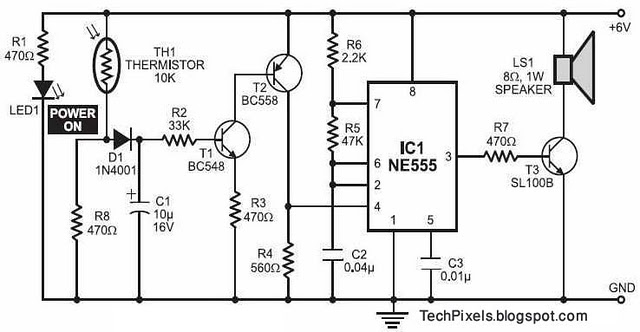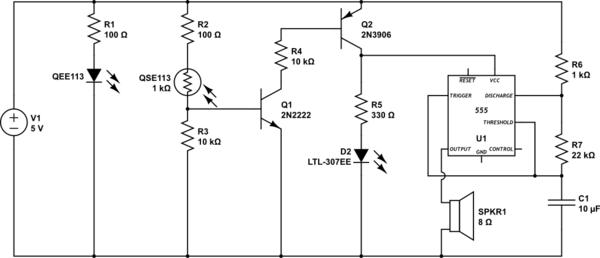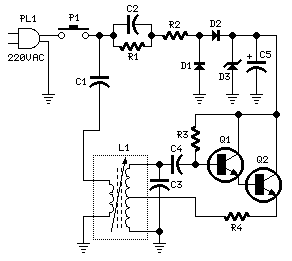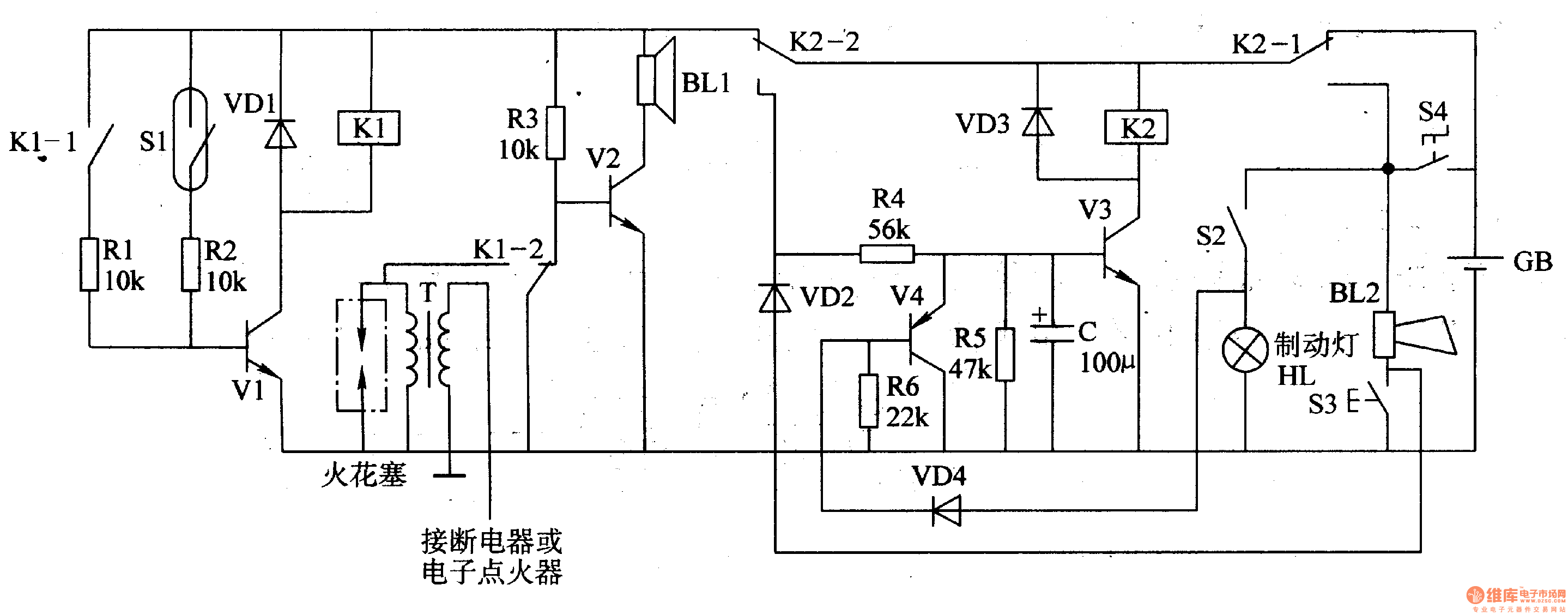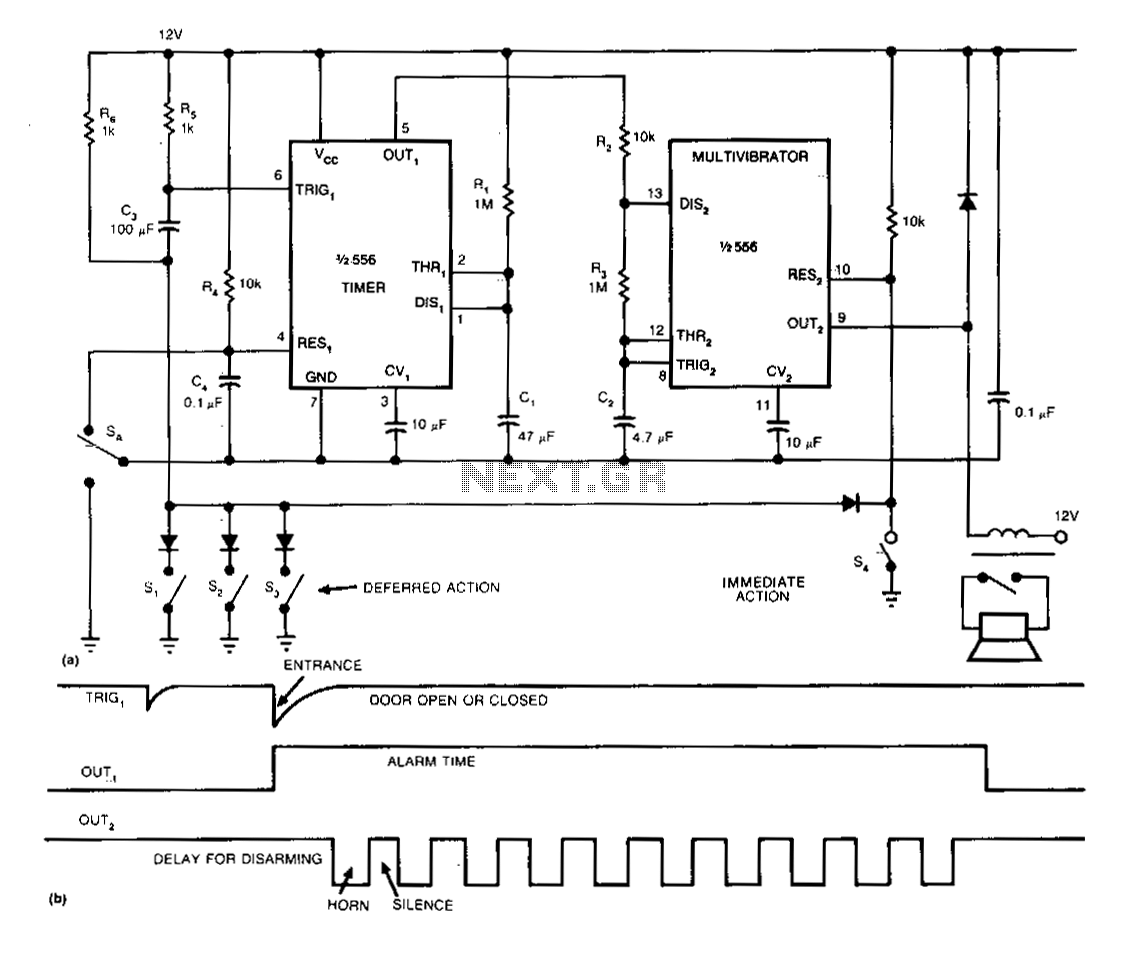
Hijack Alarm

The first circuit is designed for situations where a hijacker forces the driver from the vehicle. If a door is opened while the ignition is on, the circuit will trip. After a delay of a few minutes, when the thief is at a safe distance, the alarm will sound, and the engine will fail. Before installing this or any other engine cut-out, it is crucial to consider the safety implications of potential failure and the legal consequences of installing a device that could cause an accident. If installation proceeds, the highest standards of materials and workmanship must be utilized. The alarm may be unintentionally tripped, activating an LED and causing the buzzer to emit a short beep, the duration of which is determined by capacitor C3. This beep serves as a reminder to press the reset button. Pressing the button will turn off the LED, indicating that the alarm has reset. If the reset button is not pressed, approximately three minutes later, both the siren and buzzer will sound continuously. The delay duration is controlled by resistor R7 and capacitor C4. For enhanced auditory effect, a second siren can be installed inside the vehicle. With significant noise produced, the necessity for an engine cut-out may be reconsidered, allowing components D8, D9, R11, R12, R13, C6, Q3, Q4, and Ry2 to be omitted. Even if the initial warning from the buzzer is missed, there remains an opportunity to reset the alarm before Ry2 de-energizes and the engine fails. This additional delay, currently set to about one minute, is determined by C6 and R13. To reset the circuit, either the ignition must be turned off or all doors must be closed before pressing the reset button. While the ignition is on and a door remains open, the circuit will not reset. The reset button carries minimal current, so any small normally-open switch is sufficient. A suggestion from Eric Vandel in Canada includes using a reed switch hidden behind the dashboard and activated by a magnet, which is an effective strategy to confuse potential thieves.
The described circuit functions as a vehicle anti-theft system that integrates multiple components to ensure the safety of the driver and the vehicle. The circuit is activated when the ignition is on and a door is opened, indicating a possible hijack scenario. Upon activation, a series of alerts are triggered, starting with a visual cue from an LED and an audio signal from a buzzer, which serves as an immediate warning to the driver. The timing components, specifically the capacitor C3, are critical in defining the alert duration, ensuring that the driver has sufficient time to respond.
The subsequent alarm phase is initiated after a predetermined delay, controlled by R7 and C4, which allows the thief time to distance themselves from the vehicle before the siren and buzzer sound continuously. This delay mechanism is crucial for enhancing the effectiveness of the alarm system, as it minimizes the risk of alerting the thief prematurely.
For added deterrence, the installation of a second siren within the vehicle is recommended. This not only amplifies the alarm's sound but also increases the likelihood of attracting attention in case of a theft attempt. The design allows for flexibility, permitting the omission of certain components if the user opts for a simpler system without the engine cut-out feature.
The reset mechanism is designed to be straightforward yet secure, requiring specific conditions to be met before the alarm can be reset. This ensures that the system remains active during a potential threat, giving the driver a chance to regain control of the situation. The use of a low-current reset button provides versatility in component selection, and the suggestion of a concealed reed switch adds an element of stealth to the system, further complicating any attempts by a thief to disable it.
Overall, the design emphasizes safety, reliability, and user-friendliness, making it a robust solution for vehicle security.The first circuit was designed for the situation where a hijacker forces the driver from the vehicle. If a door is opened while the ignition is switched on - the circuit will trip. After a few minutes delay - when the thief is at a safe distance - the alarm will sound and the engine will fail.
Before fitting this or any other engine cut-out to you r vehicle - carefully consider both the safety implications of its possible failure - and the legal consequences of installing a device that could cause an accident. If you decide to proceed - you will need to use the highest standards of materials and workmanship. You`re going to trip this alarm unintentionally. When you do - the LED will light and the Buzzer will give a short beep. The length of the beep is determined by C3. Its purpose is to alert you to the need to push the reset button. When you push the button - the LED will switch-off. Its purpose is to reassure you that the alarm has in fact reset. If the reset button is not pressed then - about 3 minutes later - both the Siren and the Buzzer will sound continuously.
The length of the delay is set by R7 & C4. For extra effect - fit a second siren inside the vehicle. With enough noise going on - you may feel that it`s unnecessary to fit the engine cut-out. In which case - you can leave out D8, D9, R11, R12, R13, C6, Q3, Q4 & Ry2. Even if you missed the early warning provided by the Buzzer - there is still time to reset the alarm before Ry2 de-energizes - and the engine fails. This additional delay - currently about 1 minute - is set by C6 and R13. To reset the circuit you must - EITHER turn off the ignition - OR close all of the doors - before you press the reset button.
While BOTH the ignition is on - AND a door remains open - the circuit will NOT reset. The reset button carries virtually no current - so any small normally-open switch will do. Eric Vandel from Canada suggests using a reed-switch hidden behind (say) the dash - and operated by a magnet. I think this is an excellent idea. As Eric said in his email: - ". that should keep any thief guessing for a while. " Be the first of your friends to get free diy electronics projects, circuits diagrams, hacks, mods, gadgets & gizmo automatically each time we publish.
Your email address & privacy are safe with us ! 🔗 External reference
The described circuit functions as a vehicle anti-theft system that integrates multiple components to ensure the safety of the driver and the vehicle. The circuit is activated when the ignition is on and a door is opened, indicating a possible hijack scenario. Upon activation, a series of alerts are triggered, starting with a visual cue from an LED and an audio signal from a buzzer, which serves as an immediate warning to the driver. The timing components, specifically the capacitor C3, are critical in defining the alert duration, ensuring that the driver has sufficient time to respond.
The subsequent alarm phase is initiated after a predetermined delay, controlled by R7 and C4, which allows the thief time to distance themselves from the vehicle before the siren and buzzer sound continuously. This delay mechanism is crucial for enhancing the effectiveness of the alarm system, as it minimizes the risk of alerting the thief prematurely.
For added deterrence, the installation of a second siren within the vehicle is recommended. This not only amplifies the alarm's sound but also increases the likelihood of attracting attention in case of a theft attempt. The design allows for flexibility, permitting the omission of certain components if the user opts for a simpler system without the engine cut-out feature.
The reset mechanism is designed to be straightforward yet secure, requiring specific conditions to be met before the alarm can be reset. This ensures that the system remains active during a potential threat, giving the driver a chance to regain control of the situation. The use of a low-current reset button provides versatility in component selection, and the suggestion of a concealed reed switch adds an element of stealth to the system, further complicating any attempts by a thief to disable it.
Overall, the design emphasizes safety, reliability, and user-friendliness, making it a robust solution for vehicle security.The first circuit was designed for the situation where a hijacker forces the driver from the vehicle. If a door is opened while the ignition is switched on - the circuit will trip. After a few minutes delay - when the thief is at a safe distance - the alarm will sound and the engine will fail.
Before fitting this or any other engine cut-out to you r vehicle - carefully consider both the safety implications of its possible failure - and the legal consequences of installing a device that could cause an accident. If you decide to proceed - you will need to use the highest standards of materials and workmanship. You`re going to trip this alarm unintentionally. When you do - the LED will light and the Buzzer will give a short beep. The length of the beep is determined by C3. Its purpose is to alert you to the need to push the reset button. When you push the button - the LED will switch-off. Its purpose is to reassure you that the alarm has in fact reset. If the reset button is not pressed then - about 3 minutes later - both the Siren and the Buzzer will sound continuously.
The length of the delay is set by R7 & C4. For extra effect - fit a second siren inside the vehicle. With enough noise going on - you may feel that it`s unnecessary to fit the engine cut-out. In which case - you can leave out D8, D9, R11, R12, R13, C6, Q3, Q4 & Ry2. Even if you missed the early warning provided by the Buzzer - there is still time to reset the alarm before Ry2 de-energizes - and the engine fails. This additional delay - currently about 1 minute - is set by C6 and R13. To reset the circuit you must - EITHER turn off the ignition - OR close all of the doors - before you press the reset button.
While BOTH the ignition is on - AND a door remains open - the circuit will NOT reset. The reset button carries virtually no current - so any small normally-open switch will do. Eric Vandel from Canada suggests using a reed-switch hidden behind (say) the dash - and operated by a magnet. I think this is an excellent idea. As Eric said in his email: - ". that should keep any thief guessing for a while. " Be the first of your friends to get free diy electronics projects, circuits diagrams, hacks, mods, gadgets & gizmo automatically each time we publish.
Your email address & privacy are safe with us ! 🔗 External reference
